Analyzing Factors Affecting Teamwork in Emergency Poly-Trauma Care
VerifiedAdded on 2023/01/12
|12
|3695
|36
Report
AI Summary
This report delves into the critical factors influencing inter-professional teamwork in the emergency care of poly-trauma patients. It explores the significance of effective communication, collaborative care coordination, and the impact of various components such as individual, relational, processual, organizational, and contextual aspects on teamwork dynamics. The discussion highlights how a lack of communication, hierarchical structures, and environmental factors can impede the delivery of quality care. The report emphasizes the importance of training, interpersonal relationships, and a positive clinical environment to enhance patient outcomes and reduce medical errors. It concludes by underscoring the roles of governments, healthcare organizations, and researchers in ensuring patient safety through improved teamwork and communication strategies. The report stresses that initial management of poly-trauma patients is vital in minimizing patient morbidity and mortality. This assignment, contributed by a student, provides valuable insights for healthcare professionals and students to improve patient care.
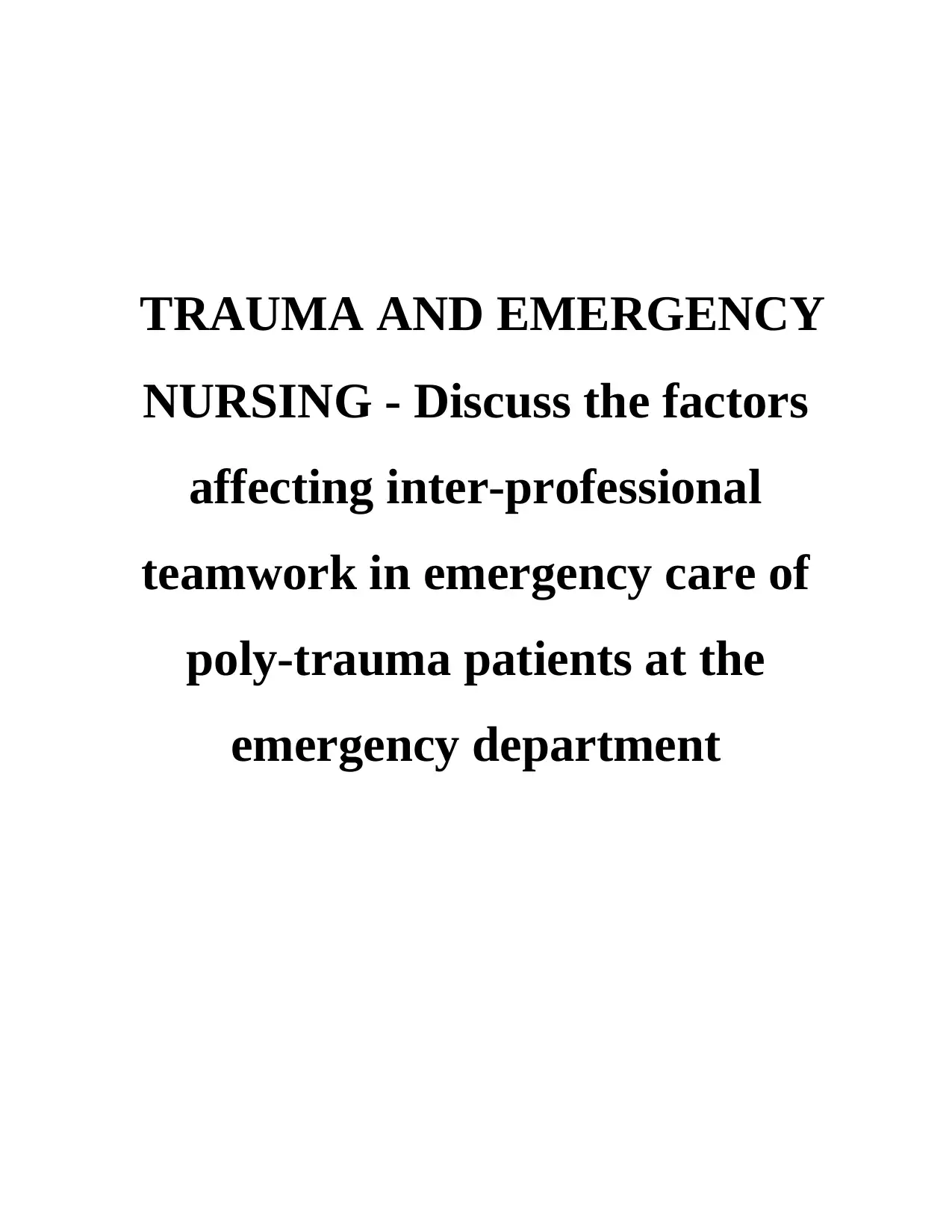
TRAUMA AND EMERGENCY
NURSING - Discuss the factors
affecting inter-professional
teamwork in emergency care of
poly-trauma patients at the
emergency department
NURSING - Discuss the factors
affecting inter-professional
teamwork in emergency care of
poly-trauma patients at the
emergency department
Paraphrase This Document
Need a fresh take? Get an instant paraphrase of this document with our AI Paraphraser
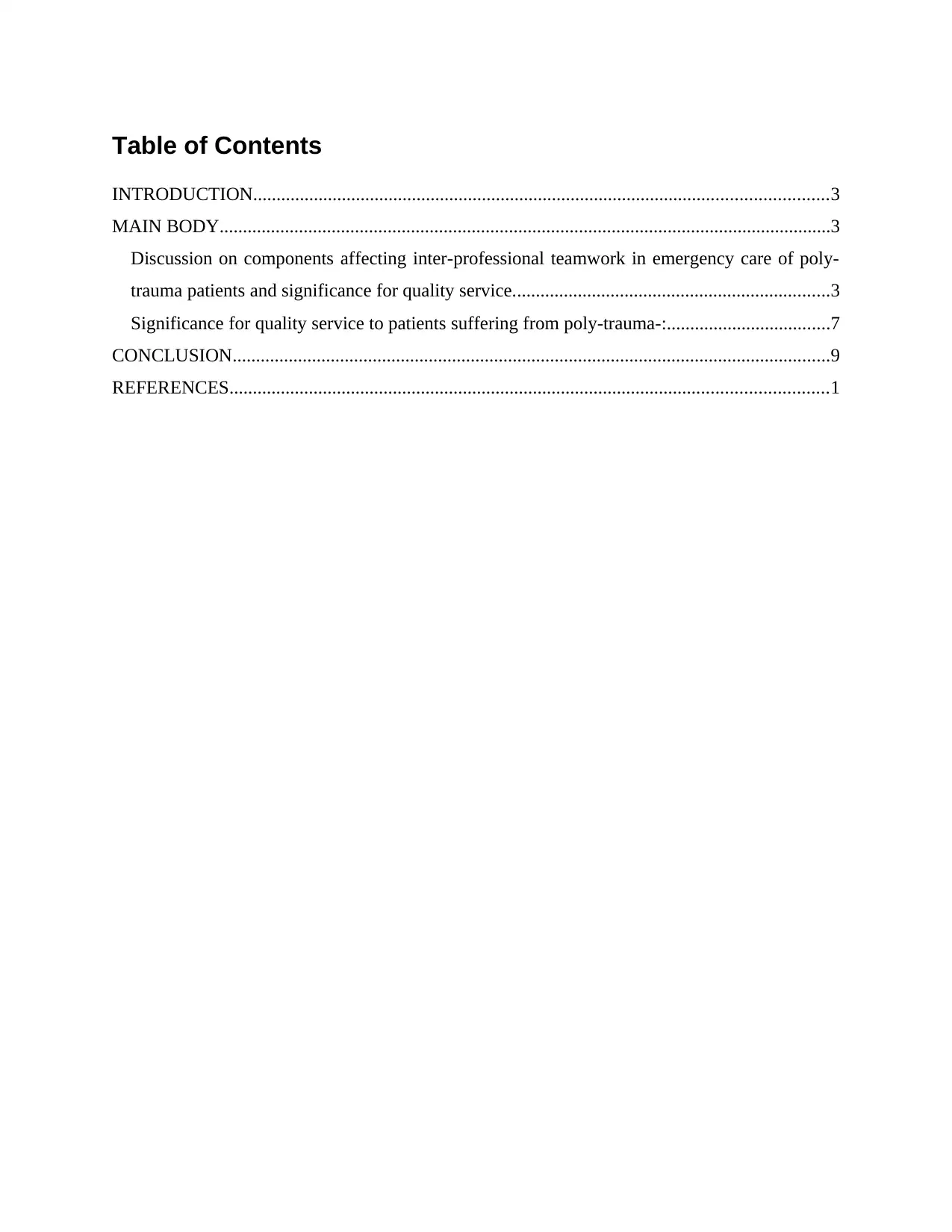
Table of Contents
INTRODUCTION...........................................................................................................................3
MAIN BODY...................................................................................................................................3
Discussion on components affecting inter-professional teamwork in emergency care of poly-
trauma patients and significance for quality service....................................................................3
Significance for quality service to patients suffering from poly-trauma-:...................................7
CONCLUSION................................................................................................................................9
REFERENCES................................................................................................................................1
INTRODUCTION...........................................................................................................................3
MAIN BODY...................................................................................................................................3
Discussion on components affecting inter-professional teamwork in emergency care of poly-
trauma patients and significance for quality service....................................................................3
Significance for quality service to patients suffering from poly-trauma-:...................................7
CONCLUSION................................................................................................................................9
REFERENCES................................................................................................................................1
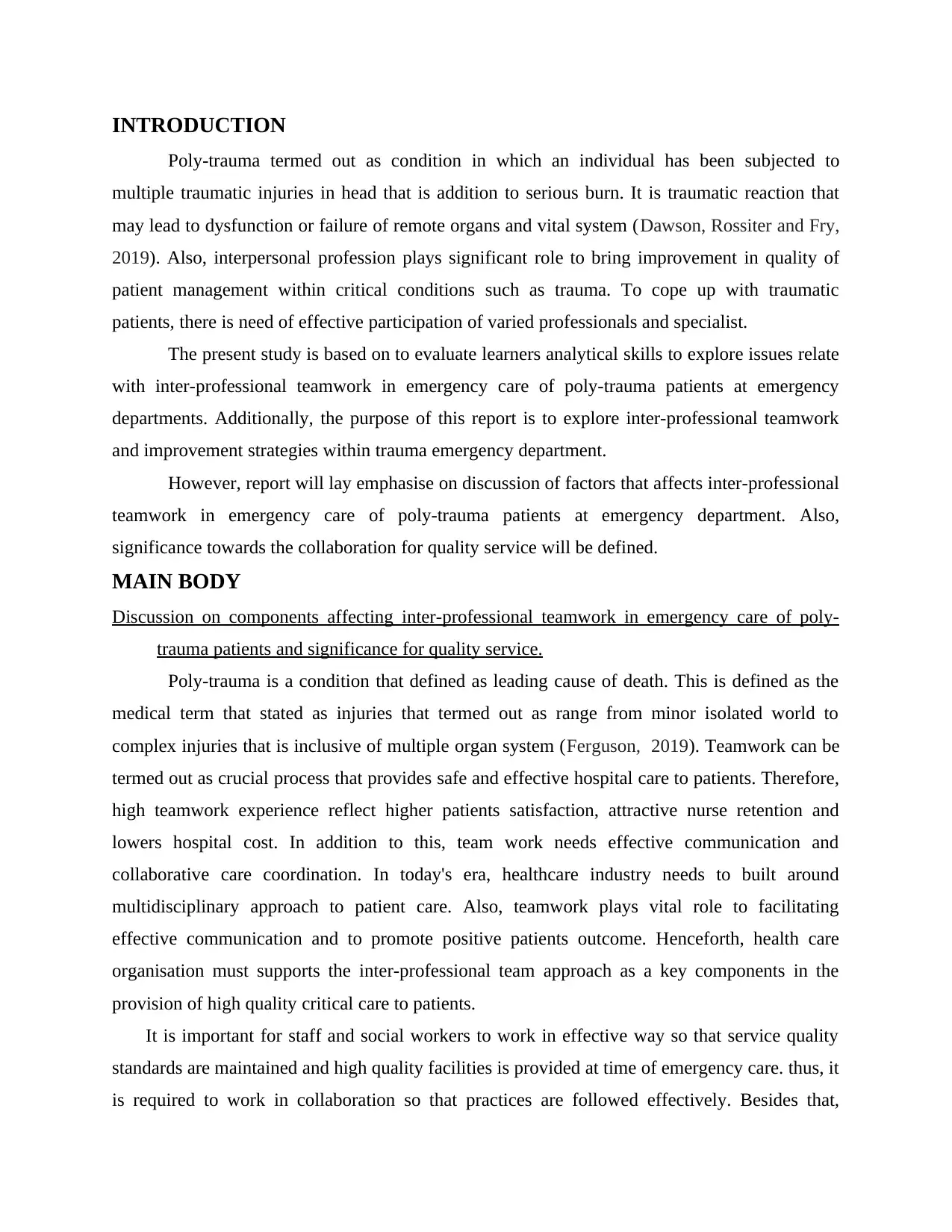
INTRODUCTION
Poly-trauma termed out as condition in which an individual has been subjected to
multiple traumatic injuries in head that is addition to serious burn. It is traumatic reaction that
may lead to dysfunction or failure of remote organs and vital system (Dawson, Rossiter and Fry,
2019). Also, interpersonal profession plays significant role to bring improvement in quality of
patient management within critical conditions such as trauma. To cope up with traumatic
patients, there is need of effective participation of varied professionals and specialist.
The present study is based on to evaluate learners analytical skills to explore issues relate
with inter-professional teamwork in emergency care of poly-trauma patients at emergency
departments. Additionally, the purpose of this report is to explore inter-professional teamwork
and improvement strategies within trauma emergency department.
However, report will lay emphasise on discussion of factors that affects inter-professional
teamwork in emergency care of poly-trauma patients at emergency department. Also,
significance towards the collaboration for quality service will be defined.
MAIN BODY
Discussion on components affecting inter-professional teamwork in emergency care of poly-
trauma patients and significance for quality service.
Poly-trauma is a condition that defined as leading cause of death. This is defined as the
medical term that stated as injuries that termed out as range from minor isolated world to
complex injuries that is inclusive of multiple organ system (Ferguson, 2019). Teamwork can be
termed out as crucial process that provides safe and effective hospital care to patients. Therefore,
high teamwork experience reflect higher patients satisfaction, attractive nurse retention and
lowers hospital cost. In addition to this, team work needs effective communication and
collaborative care coordination. In today's era, healthcare industry needs to built around
multidisciplinary approach to patient care. Also, teamwork plays vital role to facilitating
effective communication and to promote positive patients outcome. Henceforth, health care
organisation must supports the inter-professional team approach as a key components in the
provision of high quality critical care to patients.
It is important for staff and social workers to work in effective way so that service quality
standards are maintained and high quality facilities is provided at time of emergency care. thus, it
is required to work in collaboration so that practices are followed effectively. Besides that,
Poly-trauma termed out as condition in which an individual has been subjected to
multiple traumatic injuries in head that is addition to serious burn. It is traumatic reaction that
may lead to dysfunction or failure of remote organs and vital system (Dawson, Rossiter and Fry,
2019). Also, interpersonal profession plays significant role to bring improvement in quality of
patient management within critical conditions such as trauma. To cope up with traumatic
patients, there is need of effective participation of varied professionals and specialist.
The present study is based on to evaluate learners analytical skills to explore issues relate
with inter-professional teamwork in emergency care of poly-trauma patients at emergency
departments. Additionally, the purpose of this report is to explore inter-professional teamwork
and improvement strategies within trauma emergency department.
However, report will lay emphasise on discussion of factors that affects inter-professional
teamwork in emergency care of poly-trauma patients at emergency department. Also,
significance towards the collaboration for quality service will be defined.
MAIN BODY
Discussion on components affecting inter-professional teamwork in emergency care of poly-
trauma patients and significance for quality service.
Poly-trauma is a condition that defined as leading cause of death. This is defined as the
medical term that stated as injuries that termed out as range from minor isolated world to
complex injuries that is inclusive of multiple organ system (Ferguson, 2019). Teamwork can be
termed out as crucial process that provides safe and effective hospital care to patients. Therefore,
high teamwork experience reflect higher patients satisfaction, attractive nurse retention and
lowers hospital cost. In addition to this, team work needs effective communication and
collaborative care coordination. In today's era, healthcare industry needs to built around
multidisciplinary approach to patient care. Also, teamwork plays vital role to facilitating
effective communication and to promote positive patients outcome. Henceforth, health care
organisation must supports the inter-professional team approach as a key components in the
provision of high quality critical care to patients.
It is important for staff and social workers to work in effective way so that service quality
standards are maintained and high quality facilities is provided at time of emergency care. thus, it
is required to work in collaboration so that practices are followed effectively. Besides that,
⊘ This is a preview!⊘
Do you want full access?
Subscribe today to unlock all pages.

Trusted by 1+ million students worldwide
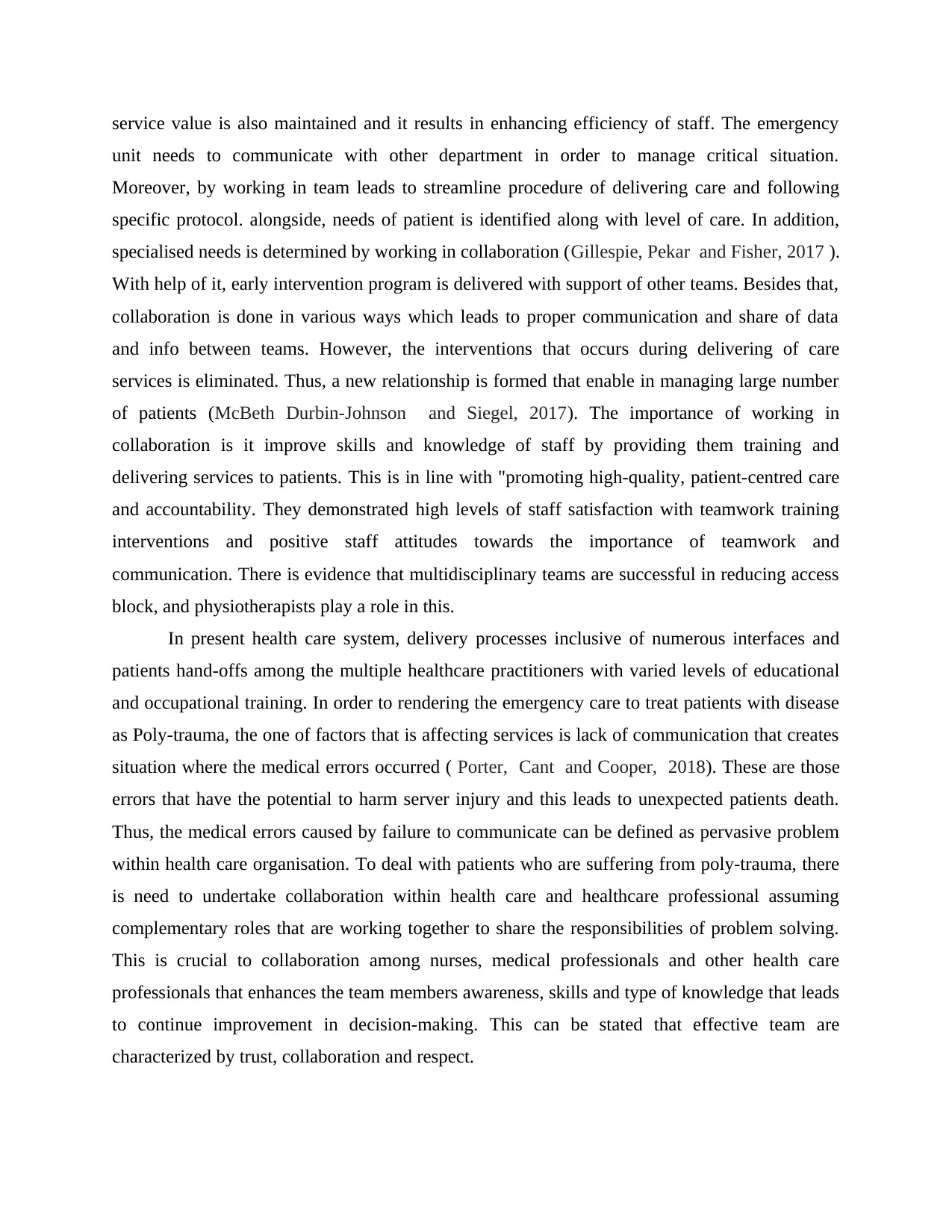
service value is also maintained and it results in enhancing efficiency of staff. The emergency
unit needs to communicate with other department in order to manage critical situation.
Moreover, by working in team leads to streamline procedure of delivering care and following
specific protocol. alongside, needs of patient is identified along with level of care. In addition,
specialised needs is determined by working in collaboration (Gillespie, Pekar and Fisher, 2017 ).
With help of it, early intervention program is delivered with support of other teams. Besides that,
collaboration is done in various ways which leads to proper communication and share of data
and info between teams. However, the interventions that occurs during delivering of care
services is eliminated. Thus, a new relationship is formed that enable in managing large number
of patients (McBeth Durbin-Johnson and Siegel, 2017). The importance of working in
collaboration is it improve skills and knowledge of staff by providing them training and
delivering services to patients. This is in line with "promoting high-quality, patient-centred care
and accountability. They demonstrated high levels of staff satisfaction with teamwork training
interventions and positive staff attitudes towards the importance of teamwork and
communication. There is evidence that multidisciplinary teams are successful in reducing access
block, and physiotherapists play a role in this.
In present health care system, delivery processes inclusive of numerous interfaces and
patients hand-offs among the multiple healthcare practitioners with varied levels of educational
and occupational training. In order to rendering the emergency care to treat patients with disease
as Poly-trauma, the one of factors that is affecting services is lack of communication that creates
situation where the medical errors occurred ( Porter, Cant and Cooper, 2018). These are those
errors that have the potential to harm server injury and this leads to unexpected patients death.
Thus, the medical errors caused by failure to communicate can be defined as pervasive problem
within health care organisation. To deal with patients who are suffering from poly-trauma, there
is need to undertake collaboration within health care and healthcare professional assuming
complementary roles that are working together to share the responsibilities of problem solving.
This is crucial to collaboration among nurses, medical professionals and other health care
professionals that enhances the team members awareness, skills and type of knowledge that leads
to continue improvement in decision-making. This can be stated that effective team are
characterized by trust, collaboration and respect.
unit needs to communicate with other department in order to manage critical situation.
Moreover, by working in team leads to streamline procedure of delivering care and following
specific protocol. alongside, needs of patient is identified along with level of care. In addition,
specialised needs is determined by working in collaboration (Gillespie, Pekar and Fisher, 2017 ).
With help of it, early intervention program is delivered with support of other teams. Besides that,
collaboration is done in various ways which leads to proper communication and share of data
and info between teams. However, the interventions that occurs during delivering of care
services is eliminated. Thus, a new relationship is formed that enable in managing large number
of patients (McBeth Durbin-Johnson and Siegel, 2017). The importance of working in
collaboration is it improve skills and knowledge of staff by providing them training and
delivering services to patients. This is in line with "promoting high-quality, patient-centred care
and accountability. They demonstrated high levels of staff satisfaction with teamwork training
interventions and positive staff attitudes towards the importance of teamwork and
communication. There is evidence that multidisciplinary teams are successful in reducing access
block, and physiotherapists play a role in this.
In present health care system, delivery processes inclusive of numerous interfaces and
patients hand-offs among the multiple healthcare practitioners with varied levels of educational
and occupational training. In order to rendering the emergency care to treat patients with disease
as Poly-trauma, the one of factors that is affecting services is lack of communication that creates
situation where the medical errors occurred ( Porter, Cant and Cooper, 2018). These are those
errors that have the potential to harm server injury and this leads to unexpected patients death.
Thus, the medical errors caused by failure to communicate can be defined as pervasive problem
within health care organisation. To deal with patients who are suffering from poly-trauma, there
is need to undertake collaboration within health care and healthcare professional assuming
complementary roles that are working together to share the responsibilities of problem solving.
This is crucial to collaboration among nurses, medical professionals and other health care
professionals that enhances the team members awareness, skills and type of knowledge that leads
to continue improvement in decision-making. This can be stated that effective team are
characterized by trust, collaboration and respect.
Paraphrase This Document
Need a fresh take? Get an instant paraphrase of this document with our AI Paraphraser
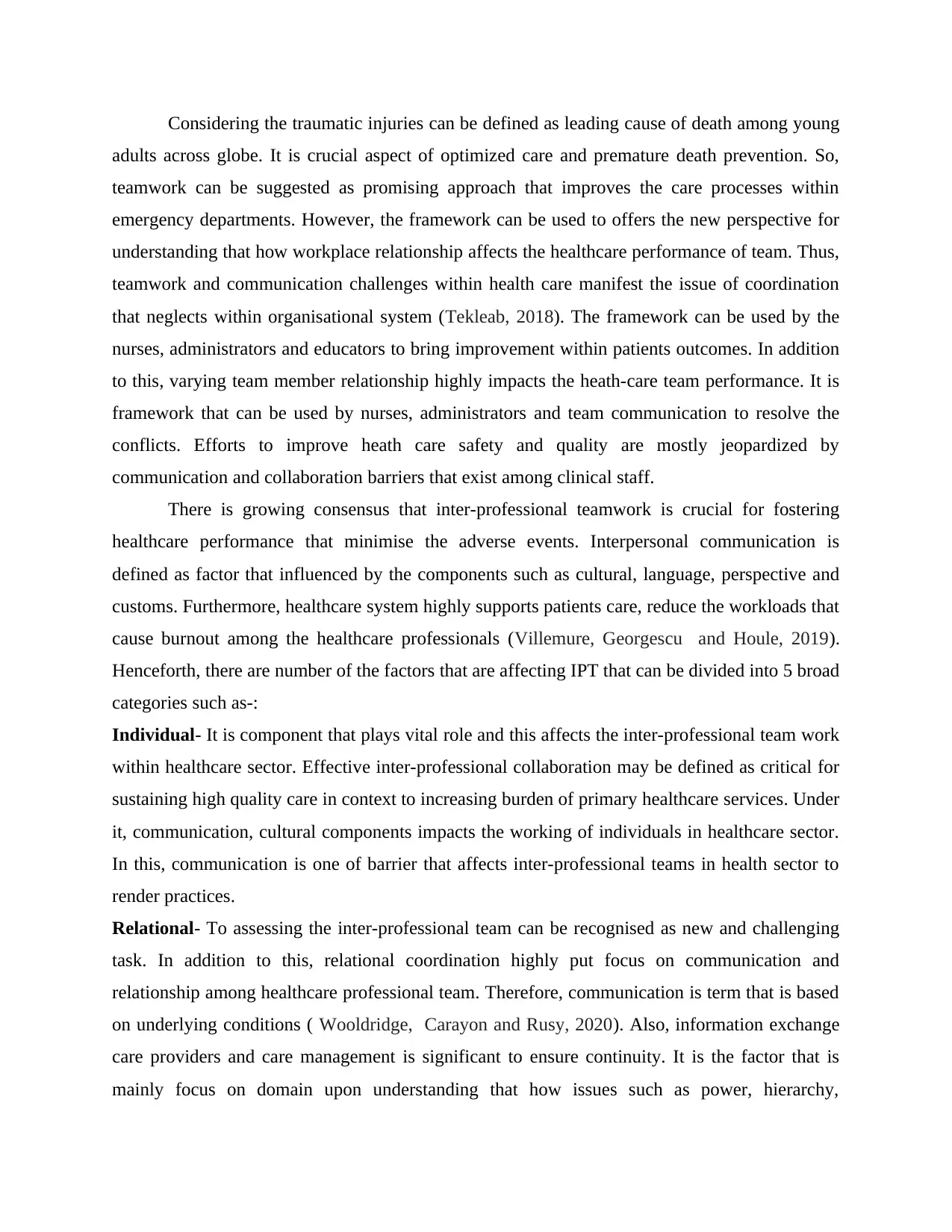
Considering the traumatic injuries can be defined as leading cause of death among young
adults across globe. It is crucial aspect of optimized care and premature death prevention. So,
teamwork can be suggested as promising approach that improves the care processes within
emergency departments. However, the framework can be used to offers the new perspective for
understanding that how workplace relationship affects the healthcare performance of team. Thus,
teamwork and communication challenges within health care manifest the issue of coordination
that neglects within organisational system (Tekleab, 2018). The framework can be used by the
nurses, administrators and educators to bring improvement within patients outcomes. In addition
to this, varying team member relationship highly impacts the heath-care team performance. It is
framework that can be used by nurses, administrators and team communication to resolve the
conflicts. Efforts to improve heath care safety and quality are mostly jeopardized by
communication and collaboration barriers that exist among clinical staff.
There is growing consensus that inter-professional teamwork is crucial for fostering
healthcare performance that minimise the adverse events. Interpersonal communication is
defined as factor that influenced by the components such as cultural, language, perspective and
customs. Furthermore, healthcare system highly supports patients care, reduce the workloads that
cause burnout among the healthcare professionals (Villemure, Georgescu and Houle, 2019).
Henceforth, there are number of the factors that are affecting IPT that can be divided into 5 broad
categories such as-:
Individual- It is component that plays vital role and this affects the inter-professional team work
within healthcare sector. Effective inter-professional collaboration may be defined as critical for
sustaining high quality care in context to increasing burden of primary healthcare services. Under
it, communication, cultural components impacts the working of individuals in healthcare sector.
In this, communication is one of barrier that affects inter-professional teams in health sector to
render practices.
Relational- To assessing the inter-professional team can be recognised as new and challenging
task. In addition to this, relational coordination highly put focus on communication and
relationship among healthcare professional team. Therefore, communication is term that is based
on underlying conditions ( Wooldridge, Carayon and Rusy, 2020). Also, information exchange
care providers and care management is significant to ensure continuity. It is the factor that is
mainly focus on domain upon understanding that how issues such as power, hierarchy,
adults across globe. It is crucial aspect of optimized care and premature death prevention. So,
teamwork can be suggested as promising approach that improves the care processes within
emergency departments. However, the framework can be used to offers the new perspective for
understanding that how workplace relationship affects the healthcare performance of team. Thus,
teamwork and communication challenges within health care manifest the issue of coordination
that neglects within organisational system (Tekleab, 2018). The framework can be used by the
nurses, administrators and educators to bring improvement within patients outcomes. In addition
to this, varying team member relationship highly impacts the heath-care team performance. It is
framework that can be used by nurses, administrators and team communication to resolve the
conflicts. Efforts to improve heath care safety and quality are mostly jeopardized by
communication and collaboration barriers that exist among clinical staff.
There is growing consensus that inter-professional teamwork is crucial for fostering
healthcare performance that minimise the adverse events. Interpersonal communication is
defined as factor that influenced by the components such as cultural, language, perspective and
customs. Furthermore, healthcare system highly supports patients care, reduce the workloads that
cause burnout among the healthcare professionals (Villemure, Georgescu and Houle, 2019).
Henceforth, there are number of the factors that are affecting IPT that can be divided into 5 broad
categories such as-:
Individual- It is component that plays vital role and this affects the inter-professional team work
within healthcare sector. Effective inter-professional collaboration may be defined as critical for
sustaining high quality care in context to increasing burden of primary healthcare services. Under
it, communication, cultural components impacts the working of individuals in healthcare sector.
In this, communication is one of barrier that affects inter-professional teams in health sector to
render practices.
Relational- To assessing the inter-professional team can be recognised as new and challenging
task. In addition to this, relational coordination highly put focus on communication and
relationship among healthcare professional team. Therefore, communication is term that is based
on underlying conditions ( Wooldridge, Carayon and Rusy, 2020). Also, information exchange
care providers and care management is significant to ensure continuity. It is the factor that is
mainly focus on domain upon understanding that how issues such as power, hierarchy,
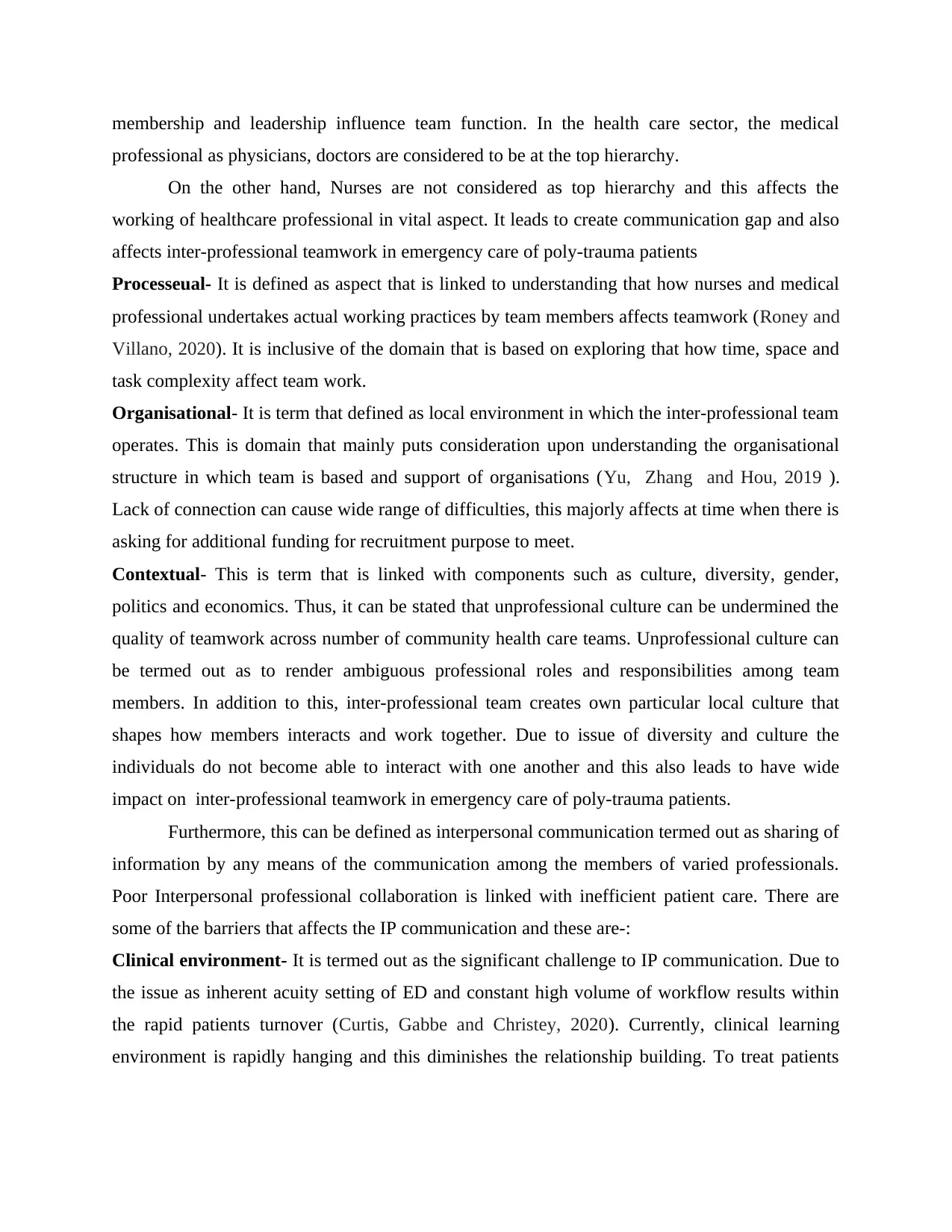
membership and leadership influence team function. In the health care sector, the medical
professional as physicians, doctors are considered to be at the top hierarchy.
On the other hand, Nurses are not considered as top hierarchy and this affects the
working of healthcare professional in vital aspect. It leads to create communication gap and also
affects inter-professional teamwork in emergency care of poly-trauma patients
Processeual- It is defined as aspect that is linked to understanding that how nurses and medical
professional undertakes actual working practices by team members affects teamwork (Roney and
Villano, 2020). It is inclusive of the domain that is based on exploring that how time, space and
task complexity affect team work.
Organisational- It is term that defined as local environment in which the inter-professional team
operates. This is domain that mainly puts consideration upon understanding the organisational
structure in which team is based and support of organisations (Yu, Zhang and Hou, 2019 ).
Lack of connection can cause wide range of difficulties, this majorly affects at time when there is
asking for additional funding for recruitment purpose to meet.
Contextual- This is term that is linked with components such as culture, diversity, gender,
politics and economics. Thus, it can be stated that unprofessional culture can be undermined the
quality of teamwork across number of community health care teams. Unprofessional culture can
be termed out as to render ambiguous professional roles and responsibilities among team
members. In addition to this, inter-professional team creates own particular local culture that
shapes how members interacts and work together. Due to issue of diversity and culture the
individuals do not become able to interact with one another and this also leads to have wide
impact on inter-professional teamwork in emergency care of poly-trauma patients.
Furthermore, this can be defined as interpersonal communication termed out as sharing of
information by any means of the communication among the members of varied professionals.
Poor Interpersonal professional collaboration is linked with inefficient patient care. There are
some of the barriers that affects the IP communication and these are-:
Clinical environment- It is termed out as the significant challenge to IP communication. Due to
the issue as inherent acuity setting of ED and constant high volume of workflow results within
the rapid patients turnover (Curtis, Gabbe and Christey, 2020). Currently, clinical learning
environment is rapidly hanging and this diminishes the relationship building. To treat patients
professional as physicians, doctors are considered to be at the top hierarchy.
On the other hand, Nurses are not considered as top hierarchy and this affects the
working of healthcare professional in vital aspect. It leads to create communication gap and also
affects inter-professional teamwork in emergency care of poly-trauma patients
Processeual- It is defined as aspect that is linked to understanding that how nurses and medical
professional undertakes actual working practices by team members affects teamwork (Roney and
Villano, 2020). It is inclusive of the domain that is based on exploring that how time, space and
task complexity affect team work.
Organisational- It is term that defined as local environment in which the inter-professional team
operates. This is domain that mainly puts consideration upon understanding the organisational
structure in which team is based and support of organisations (Yu, Zhang and Hou, 2019 ).
Lack of connection can cause wide range of difficulties, this majorly affects at time when there is
asking for additional funding for recruitment purpose to meet.
Contextual- This is term that is linked with components such as culture, diversity, gender,
politics and economics. Thus, it can be stated that unprofessional culture can be undermined the
quality of teamwork across number of community health care teams. Unprofessional culture can
be termed out as to render ambiguous professional roles and responsibilities among team
members. In addition to this, inter-professional team creates own particular local culture that
shapes how members interacts and work together. Due to issue of diversity and culture the
individuals do not become able to interact with one another and this also leads to have wide
impact on inter-professional teamwork in emergency care of poly-trauma patients.
Furthermore, this can be defined as interpersonal communication termed out as sharing of
information by any means of the communication among the members of varied professionals.
Poor Interpersonal professional collaboration is linked with inefficient patient care. There are
some of the barriers that affects the IP communication and these are-:
Clinical environment- It is termed out as the significant challenge to IP communication. Due to
the issue as inherent acuity setting of ED and constant high volume of workflow results within
the rapid patients turnover (Curtis, Gabbe and Christey, 2020). Currently, clinical learning
environment is rapidly hanging and this diminishes the relationship building. To treat patients
⊘ This is a preview!⊘
Do you want full access?
Subscribe today to unlock all pages.

Trusted by 1+ million students worldwide
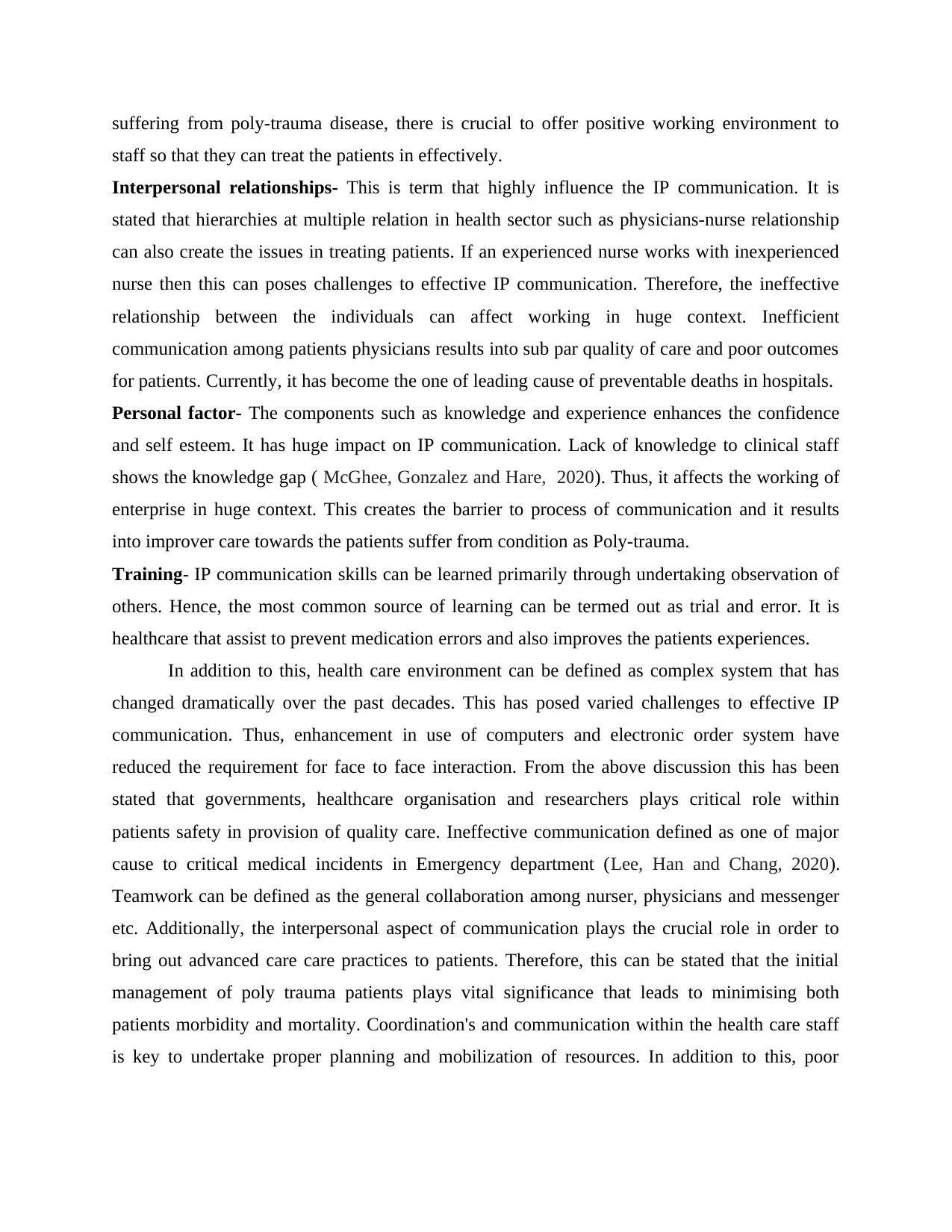
suffering from poly-trauma disease, there is crucial to offer positive working environment to
staff so that they can treat the patients in effectively.
Interpersonal relationships- This is term that highly influence the IP communication. It is
stated that hierarchies at multiple relation in health sector such as physicians-nurse relationship
can also create the issues in treating patients. If an experienced nurse works with inexperienced
nurse then this can poses challenges to effective IP communication. Therefore, the ineffective
relationship between the individuals can affect working in huge context. Inefficient
communication among patients physicians results into sub par quality of care and poor outcomes
for patients. Currently, it has become the one of leading cause of preventable deaths in hospitals.
Personal factor- The components such as knowledge and experience enhances the confidence
and self esteem. It has huge impact on IP communication. Lack of knowledge to clinical staff
shows the knowledge gap ( McGhee, Gonzalez and Hare, 2020). Thus, it affects the working of
enterprise in huge context. This creates the barrier to process of communication and it results
into improver care towards the patients suffer from condition as Poly-trauma.
Training- IP communication skills can be learned primarily through undertaking observation of
others. Hence, the most common source of learning can be termed out as trial and error. It is
healthcare that assist to prevent medication errors and also improves the patients experiences.
In addition to this, health care environment can be defined as complex system that has
changed dramatically over the past decades. This has posed varied challenges to effective IP
communication. Thus, enhancement in use of computers and electronic order system have
reduced the requirement for face to face interaction. From the above discussion this has been
stated that governments, healthcare organisation and researchers plays critical role within
patients safety in provision of quality care. Ineffective communication defined as one of major
cause to critical medical incidents in Emergency department (Lee, Han and Chang, 2020).
Teamwork can be defined as the general collaboration among nurser, physicians and messenger
etc. Additionally, the interpersonal aspect of communication plays the crucial role in order to
bring out advanced care care practices to patients. Therefore, this can be stated that the initial
management of poly trauma patients plays vital significance that leads to minimising both
patients morbidity and mortality. Coordination's and communication within the health care staff
is key to undertake proper planning and mobilization of resources. In addition to this, poor
staff so that they can treat the patients in effectively.
Interpersonal relationships- This is term that highly influence the IP communication. It is
stated that hierarchies at multiple relation in health sector such as physicians-nurse relationship
can also create the issues in treating patients. If an experienced nurse works with inexperienced
nurse then this can poses challenges to effective IP communication. Therefore, the ineffective
relationship between the individuals can affect working in huge context. Inefficient
communication among patients physicians results into sub par quality of care and poor outcomes
for patients. Currently, it has become the one of leading cause of preventable deaths in hospitals.
Personal factor- The components such as knowledge and experience enhances the confidence
and self esteem. It has huge impact on IP communication. Lack of knowledge to clinical staff
shows the knowledge gap ( McGhee, Gonzalez and Hare, 2020). Thus, it affects the working of
enterprise in huge context. This creates the barrier to process of communication and it results
into improver care towards the patients suffer from condition as Poly-trauma.
Training- IP communication skills can be learned primarily through undertaking observation of
others. Hence, the most common source of learning can be termed out as trial and error. It is
healthcare that assist to prevent medication errors and also improves the patients experiences.
In addition to this, health care environment can be defined as complex system that has
changed dramatically over the past decades. This has posed varied challenges to effective IP
communication. Thus, enhancement in use of computers and electronic order system have
reduced the requirement for face to face interaction. From the above discussion this has been
stated that governments, healthcare organisation and researchers plays critical role within
patients safety in provision of quality care. Ineffective communication defined as one of major
cause to critical medical incidents in Emergency department (Lee, Han and Chang, 2020).
Teamwork can be defined as the general collaboration among nurser, physicians and messenger
etc. Additionally, the interpersonal aspect of communication plays the crucial role in order to
bring out advanced care care practices to patients. Therefore, this can be stated that the initial
management of poly trauma patients plays vital significance that leads to minimising both
patients morbidity and mortality. Coordination's and communication within the health care staff
is key to undertake proper planning and mobilization of resources. In addition to this, poor
Paraphrase This Document
Need a fresh take? Get an instant paraphrase of this document with our AI Paraphraser
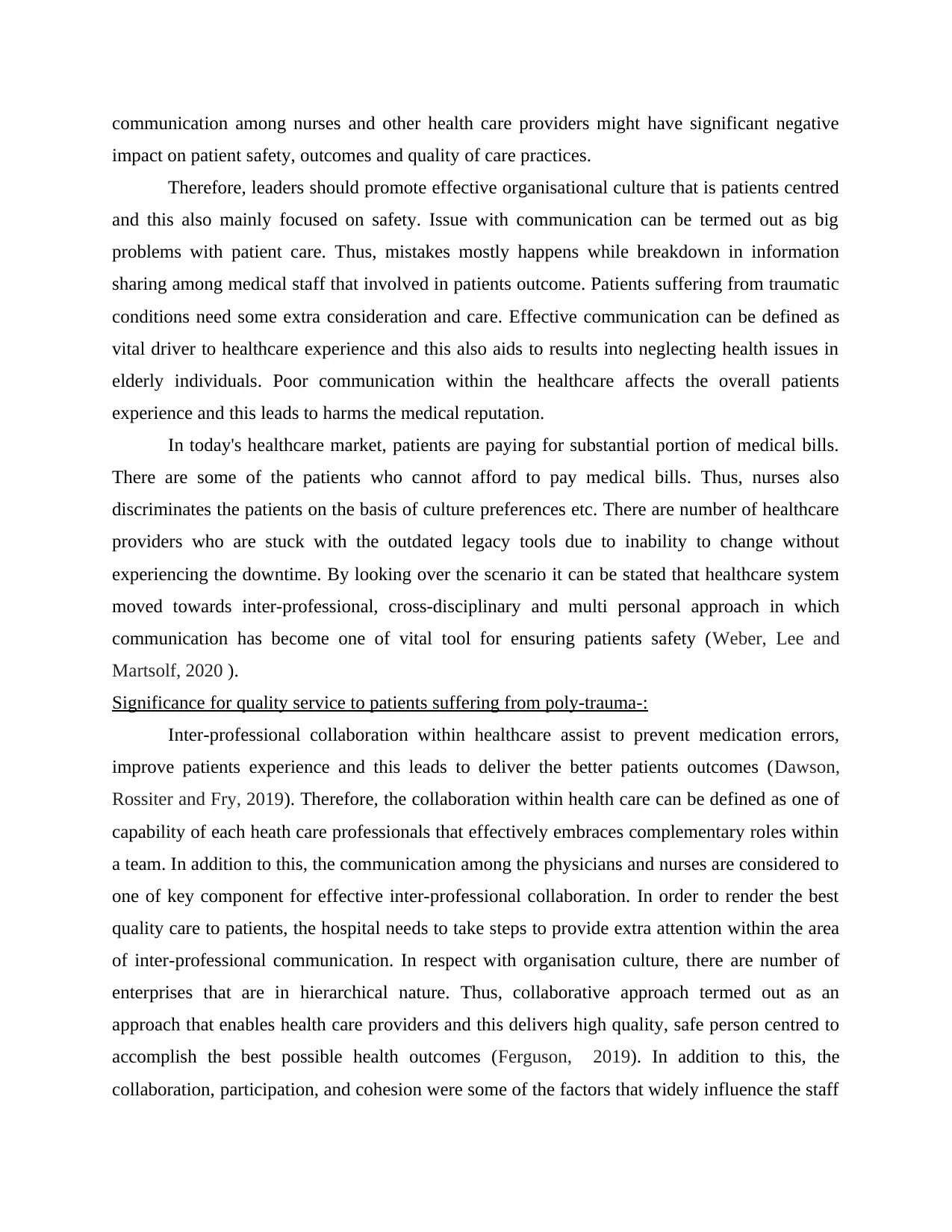
communication among nurses and other health care providers might have significant negative
impact on patient safety, outcomes and quality of care practices.
Therefore, leaders should promote effective organisational culture that is patients centred
and this also mainly focused on safety. Issue with communication can be termed out as big
problems with patient care. Thus, mistakes mostly happens while breakdown in information
sharing among medical staff that involved in patients outcome. Patients suffering from traumatic
conditions need some extra consideration and care. Effective communication can be defined as
vital driver to healthcare experience and this also aids to results into neglecting health issues in
elderly individuals. Poor communication within the healthcare affects the overall patients
experience and this leads to harms the medical reputation.
In today's healthcare market, patients are paying for substantial portion of medical bills.
There are some of the patients who cannot afford to pay medical bills. Thus, nurses also
discriminates the patients on the basis of culture preferences etc. There are number of healthcare
providers who are stuck with the outdated legacy tools due to inability to change without
experiencing the downtime. By looking over the scenario it can be stated that healthcare system
moved towards inter-professional, cross-disciplinary and multi personal approach in which
communication has become one of vital tool for ensuring patients safety (Weber, Lee and
Martsolf, 2020 ).
Significance for quality service to patients suffering from poly-trauma-:
Inter-professional collaboration within healthcare assist to prevent medication errors,
improve patients experience and this leads to deliver the better patients outcomes (Dawson,
Rossiter and Fry, 2019). Therefore, the collaboration within health care can be defined as one of
capability of each heath care professionals that effectively embraces complementary roles within
a team. In addition to this, the communication among the physicians and nurses are considered to
one of key component for effective inter-professional collaboration. In order to render the best
quality care to patients, the hospital needs to take steps to provide extra attention within the area
of inter-professional communication. In respect with organisation culture, there are number of
enterprises that are in hierarchical nature. Thus, collaborative approach termed out as an
approach that enables health care providers and this delivers high quality, safe person centred to
accomplish the best possible health outcomes (Ferguson, 2019). In addition to this, the
collaboration, participation, and cohesion were some of the factors that widely influence the staff
impact on patient safety, outcomes and quality of care practices.
Therefore, leaders should promote effective organisational culture that is patients centred
and this also mainly focused on safety. Issue with communication can be termed out as big
problems with patient care. Thus, mistakes mostly happens while breakdown in information
sharing among medical staff that involved in patients outcome. Patients suffering from traumatic
conditions need some extra consideration and care. Effective communication can be defined as
vital driver to healthcare experience and this also aids to results into neglecting health issues in
elderly individuals. Poor communication within the healthcare affects the overall patients
experience and this leads to harms the medical reputation.
In today's healthcare market, patients are paying for substantial portion of medical bills.
There are some of the patients who cannot afford to pay medical bills. Thus, nurses also
discriminates the patients on the basis of culture preferences etc. There are number of healthcare
providers who are stuck with the outdated legacy tools due to inability to change without
experiencing the downtime. By looking over the scenario it can be stated that healthcare system
moved towards inter-professional, cross-disciplinary and multi personal approach in which
communication has become one of vital tool for ensuring patients safety (Weber, Lee and
Martsolf, 2020 ).
Significance for quality service to patients suffering from poly-trauma-:
Inter-professional collaboration within healthcare assist to prevent medication errors,
improve patients experience and this leads to deliver the better patients outcomes (Dawson,
Rossiter and Fry, 2019). Therefore, the collaboration within health care can be defined as one of
capability of each heath care professionals that effectively embraces complementary roles within
a team. In addition to this, the communication among the physicians and nurses are considered to
one of key component for effective inter-professional collaboration. In order to render the best
quality care to patients, the hospital needs to take steps to provide extra attention within the area
of inter-professional communication. In respect with organisation culture, there are number of
enterprises that are in hierarchical nature. Thus, collaborative approach termed out as an
approach that enables health care providers and this delivers high quality, safe person centred to
accomplish the best possible health outcomes (Ferguson, 2019). In addition to this, the
collaboration, participation, and cohesion were some of the factors that widely influence the staff
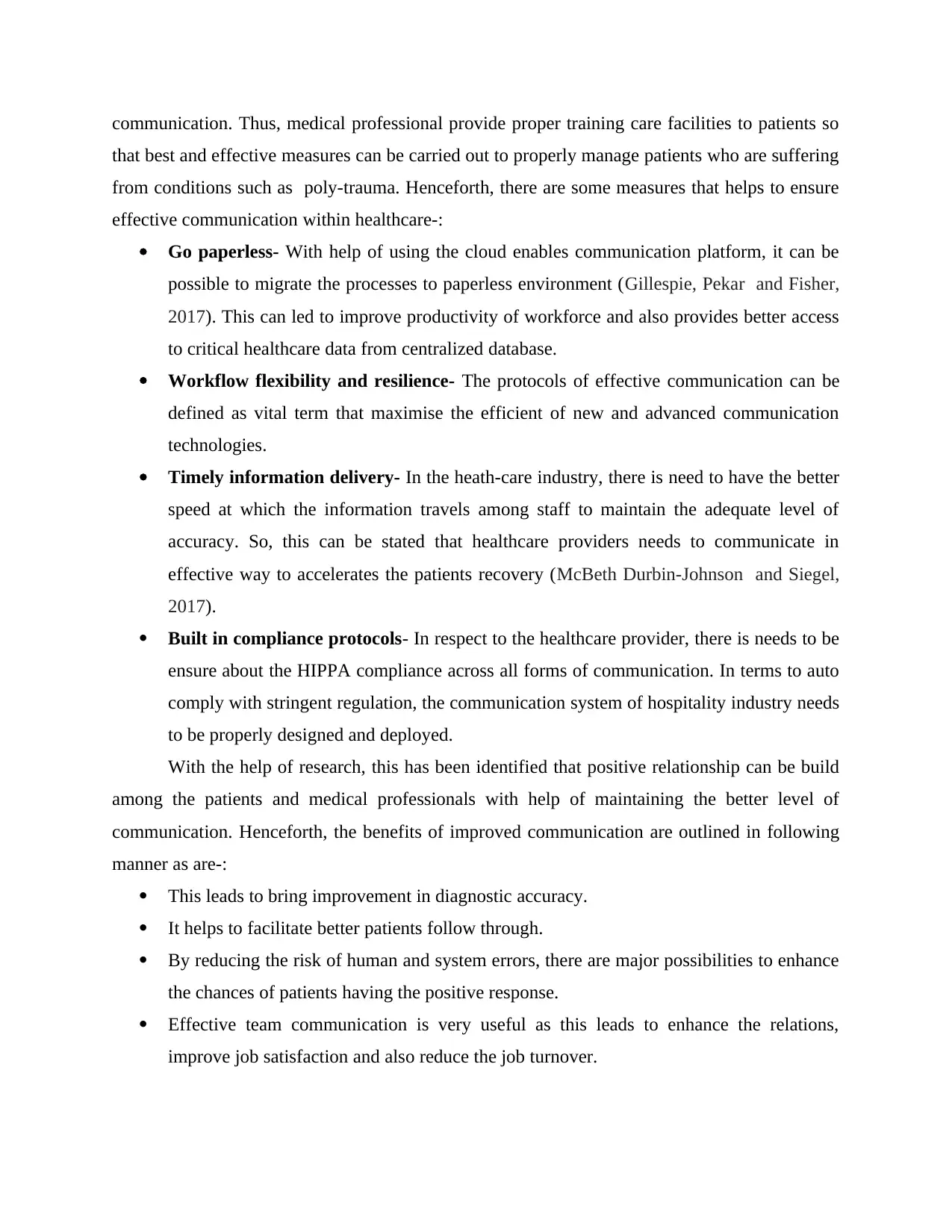
communication. Thus, medical professional provide proper training care facilities to patients so
that best and effective measures can be carried out to properly manage patients who are suffering
from conditions such as poly-trauma. Henceforth, there are some measures that helps to ensure
effective communication within healthcare-:
Go paperless- With help of using the cloud enables communication platform, it can be
possible to migrate the processes to paperless environment (Gillespie, Pekar and Fisher,
2017). This can led to improve productivity of workforce and also provides better access
to critical healthcare data from centralized database.
Workflow flexibility and resilience- The protocols of effective communication can be
defined as vital term that maximise the efficient of new and advanced communication
technologies.
Timely information delivery- In the heath-care industry, there is need to have the better
speed at which the information travels among staff to maintain the adequate level of
accuracy. So, this can be stated that healthcare providers needs to communicate in
effective way to accelerates the patients recovery (McBeth Durbin-Johnson and Siegel,
2017).
Built in compliance protocols- In respect to the healthcare provider, there is needs to be
ensure about the HIPPA compliance across all forms of communication. In terms to auto
comply with stringent regulation, the communication system of hospitality industry needs
to be properly designed and deployed.
With the help of research, this has been identified that positive relationship can be build
among the patients and medical professionals with help of maintaining the better level of
communication. Henceforth, the benefits of improved communication are outlined in following
manner as are-:
This leads to bring improvement in diagnostic accuracy.
It helps to facilitate better patients follow through.
By reducing the risk of human and system errors, there are major possibilities to enhance
the chances of patients having the positive response.
Effective team communication is very useful as this leads to enhance the relations,
improve job satisfaction and also reduce the job turnover.
that best and effective measures can be carried out to properly manage patients who are suffering
from conditions such as poly-trauma. Henceforth, there are some measures that helps to ensure
effective communication within healthcare-:
Go paperless- With help of using the cloud enables communication platform, it can be
possible to migrate the processes to paperless environment (Gillespie, Pekar and Fisher,
2017). This can led to improve productivity of workforce and also provides better access
to critical healthcare data from centralized database.
Workflow flexibility and resilience- The protocols of effective communication can be
defined as vital term that maximise the efficient of new and advanced communication
technologies.
Timely information delivery- In the heath-care industry, there is need to have the better
speed at which the information travels among staff to maintain the adequate level of
accuracy. So, this can be stated that healthcare providers needs to communicate in
effective way to accelerates the patients recovery (McBeth Durbin-Johnson and Siegel,
2017).
Built in compliance protocols- In respect to the healthcare provider, there is needs to be
ensure about the HIPPA compliance across all forms of communication. In terms to auto
comply with stringent regulation, the communication system of hospitality industry needs
to be properly designed and deployed.
With the help of research, this has been identified that positive relationship can be build
among the patients and medical professionals with help of maintaining the better level of
communication. Henceforth, the benefits of improved communication are outlined in following
manner as are-:
This leads to bring improvement in diagnostic accuracy.
It helps to facilitate better patients follow through.
By reducing the risk of human and system errors, there are major possibilities to enhance
the chances of patients having the positive response.
Effective team communication is very useful as this leads to enhance the relations,
improve job satisfaction and also reduce the job turnover.
⊘ This is a preview!⊘
Do you want full access?
Subscribe today to unlock all pages.

Trusted by 1+ million students worldwide
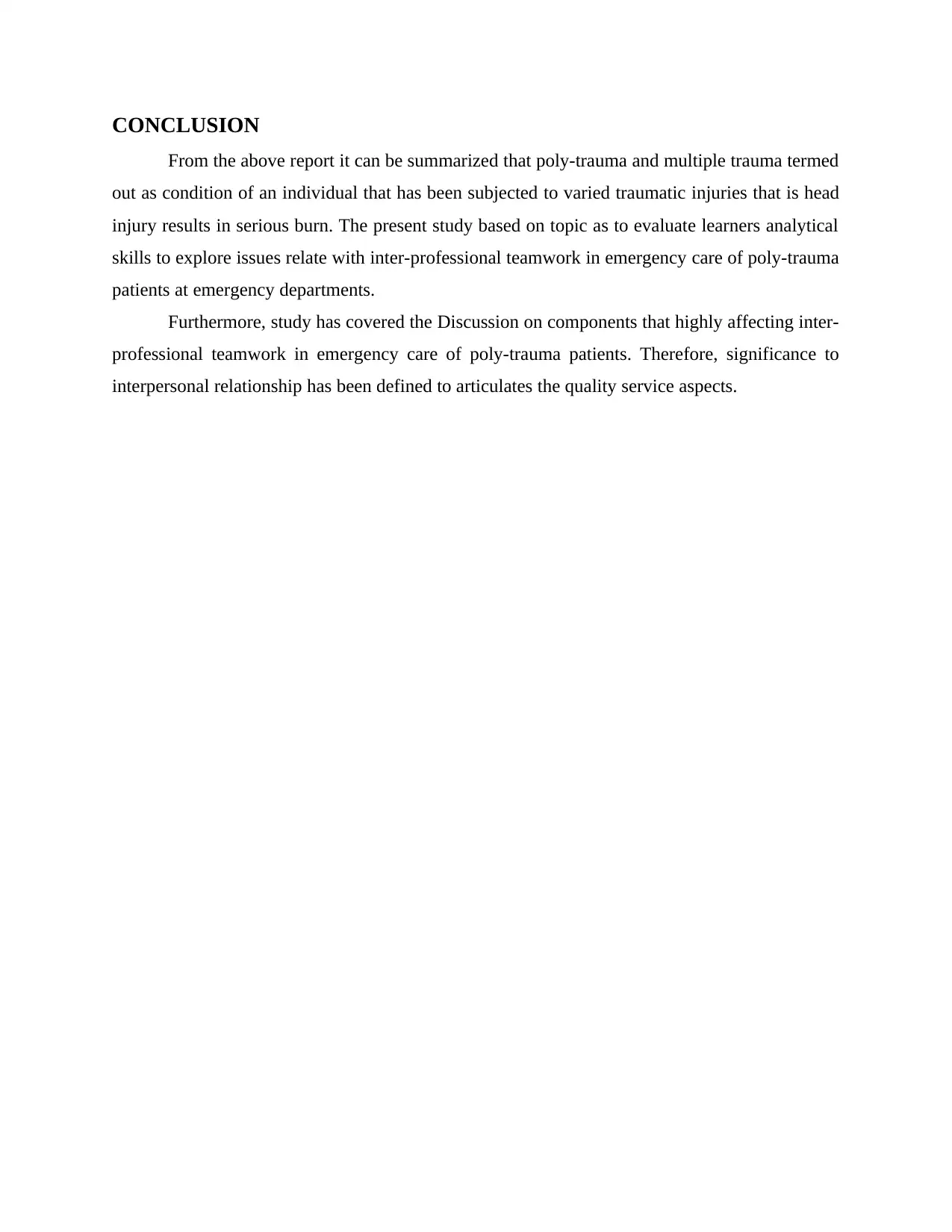
CONCLUSION
From the above report it can be summarized that poly-trauma and multiple trauma termed
out as condition of an individual that has been subjected to varied traumatic injuries that is head
injury results in serious burn. The present study based on topic as to evaluate learners analytical
skills to explore issues relate with inter-professional teamwork in emergency care of poly-trauma
patients at emergency departments.
Furthermore, study has covered the Discussion on components that highly affecting inter-
professional teamwork in emergency care of poly-trauma patients. Therefore, significance to
interpersonal relationship has been defined to articulates the quality service aspects.
From the above report it can be summarized that poly-trauma and multiple trauma termed
out as condition of an individual that has been subjected to varied traumatic injuries that is head
injury results in serious burn. The present study based on topic as to evaluate learners analytical
skills to explore issues relate with inter-professional teamwork in emergency care of poly-trauma
patients at emergency departments.
Furthermore, study has covered the Discussion on components that highly affecting inter-
professional teamwork in emergency care of poly-trauma patients. Therefore, significance to
interpersonal relationship has been defined to articulates the quality service aspects.
Paraphrase This Document
Need a fresh take? Get an instant paraphrase of this document with our AI Paraphraser
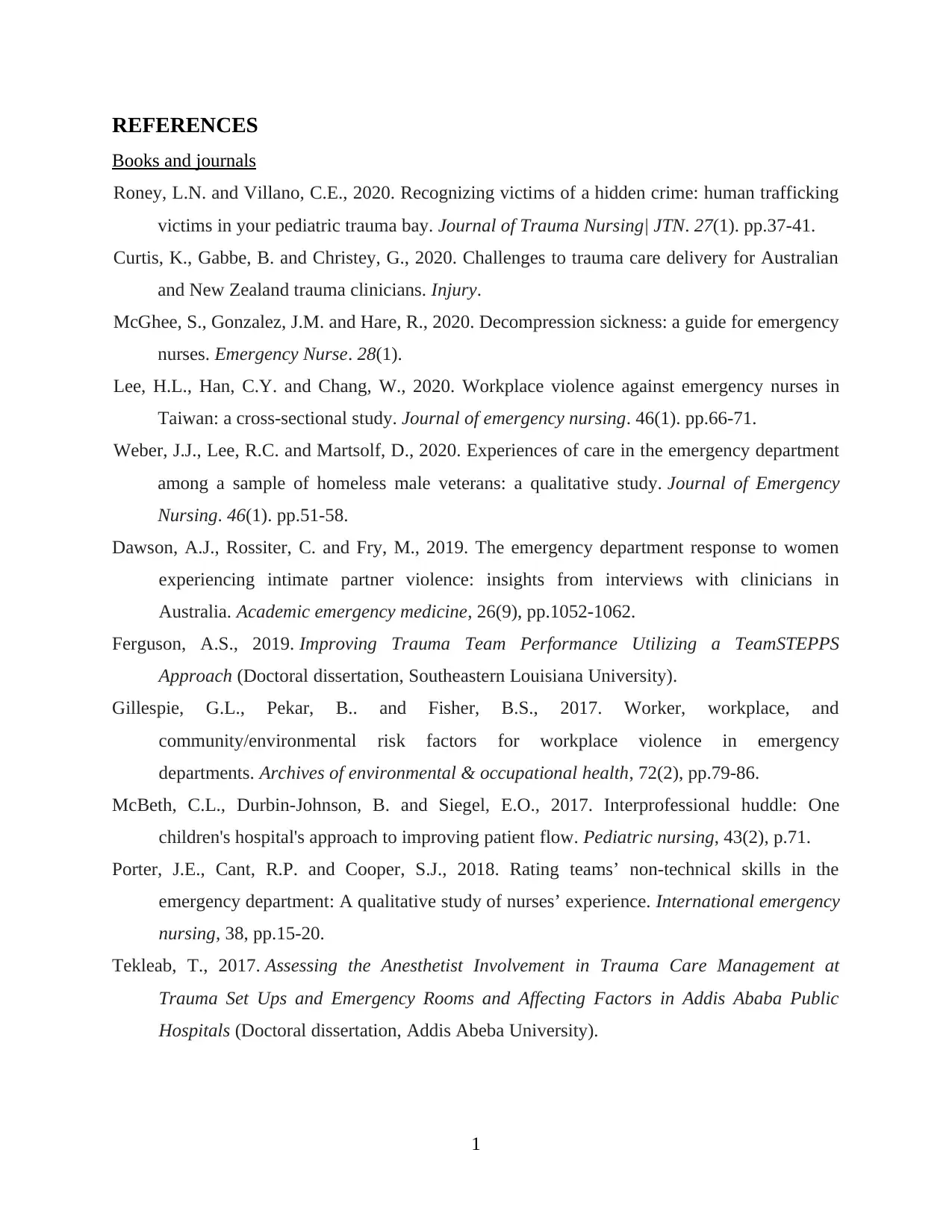
REFERENCES
Books and journals
Roney, L.N. and Villano, C.E., 2020. Recognizing victims of a hidden crime: human trafficking
victims in your pediatric trauma bay. Journal of Trauma Nursing| JTN. 27(1). pp.37-41.
Curtis, K., Gabbe, B. and Christey, G., 2020. Challenges to trauma care delivery for Australian
and New Zealand trauma clinicians. Injury.
McGhee, S., Gonzalez, J.M. and Hare, R., 2020. Decompression sickness: a guide for emergency
nurses. Emergency Nurse. 28(1).
Lee, H.L., Han, C.Y. and Chang, W., 2020. Workplace violence against emergency nurses in
Taiwan: a cross-sectional study. Journal of emergency nursing. 46(1). pp.66-71.
Weber, J.J., Lee, R.C. and Martsolf, D., 2020. Experiences of care in the emergency department
among a sample of homeless male veterans: a qualitative study. Journal of Emergency
Nursing. 46(1). pp.51-58.
Dawson, A.J., Rossiter, C. and Fry, M., 2019. The emergency department response to women
experiencing intimate partner violence: insights from interviews with clinicians in
Australia. Academic emergency medicine, 26(9), pp.1052-1062.
Ferguson, A.S., 2019. Improving Trauma Team Performance Utilizing a TeamSTEPPS
Approach (Doctoral dissertation, Southeastern Louisiana University).
Gillespie, G.L., Pekar, B.. and Fisher, B.S., 2017. Worker, workplace, and
community/environmental risk factors for workplace violence in emergency
departments. Archives of environmental & occupational health, 72(2), pp.79-86.
McBeth, C.L., Durbin-Johnson, B. and Siegel, E.O., 2017. Interprofessional huddle: One
children's hospital's approach to improving patient flow. Pediatric nursing, 43(2), p.71.
Porter, J.E., Cant, R.P. and Cooper, S.J., 2018. Rating teams’ non-technical skills in the
emergency department: A qualitative study of nurses’ experience. International emergency
nursing, 38, pp.15-20.
Tekleab, T., 2017. Assessing the Anesthetist Involvement in Trauma Care Management at
Trauma Set Ups and Emergency Rooms and Affecting Factors in Addis Ababa Public
Hospitals (Doctoral dissertation, Addis Abeba University).
1
Books and journals
Roney, L.N. and Villano, C.E., 2020. Recognizing victims of a hidden crime: human trafficking
victims in your pediatric trauma bay. Journal of Trauma Nursing| JTN. 27(1). pp.37-41.
Curtis, K., Gabbe, B. and Christey, G., 2020. Challenges to trauma care delivery for Australian
and New Zealand trauma clinicians. Injury.
McGhee, S., Gonzalez, J.M. and Hare, R., 2020. Decompression sickness: a guide for emergency
nurses. Emergency Nurse. 28(1).
Lee, H.L., Han, C.Y. and Chang, W., 2020. Workplace violence against emergency nurses in
Taiwan: a cross-sectional study. Journal of emergency nursing. 46(1). pp.66-71.
Weber, J.J., Lee, R.C. and Martsolf, D., 2020. Experiences of care in the emergency department
among a sample of homeless male veterans: a qualitative study. Journal of Emergency
Nursing. 46(1). pp.51-58.
Dawson, A.J., Rossiter, C. and Fry, M., 2019. The emergency department response to women
experiencing intimate partner violence: insights from interviews with clinicians in
Australia. Academic emergency medicine, 26(9), pp.1052-1062.
Ferguson, A.S., 2019. Improving Trauma Team Performance Utilizing a TeamSTEPPS
Approach (Doctoral dissertation, Southeastern Louisiana University).
Gillespie, G.L., Pekar, B.. and Fisher, B.S., 2017. Worker, workplace, and
community/environmental risk factors for workplace violence in emergency
departments. Archives of environmental & occupational health, 72(2), pp.79-86.
McBeth, C.L., Durbin-Johnson, B. and Siegel, E.O., 2017. Interprofessional huddle: One
children's hospital's approach to improving patient flow. Pediatric nursing, 43(2), p.71.
Porter, J.E., Cant, R.P. and Cooper, S.J., 2018. Rating teams’ non-technical skills in the
emergency department: A qualitative study of nurses’ experience. International emergency
nursing, 38, pp.15-20.
Tekleab, T., 2017. Assessing the Anesthetist Involvement in Trauma Care Management at
Trauma Set Ups and Emergency Rooms and Affecting Factors in Addis Ababa Public
Hospitals (Doctoral dissertation, Addis Abeba University).
1
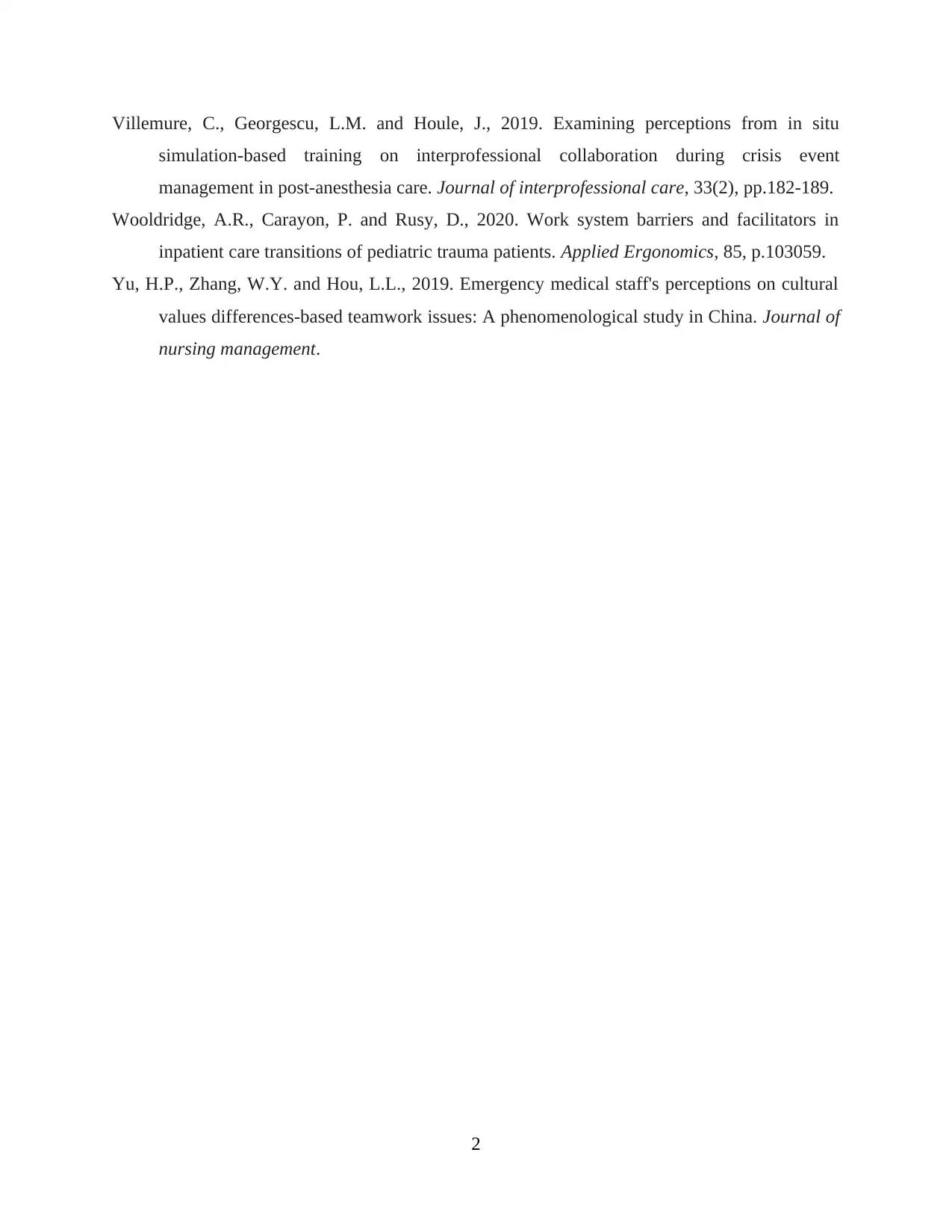
Villemure, C., Georgescu, L.M. and Houle, J., 2019. Examining perceptions from in situ
simulation-based training on interprofessional collaboration during crisis event
management in post-anesthesia care. Journal of interprofessional care, 33(2), pp.182-189.
Wooldridge, A.R., Carayon, P. and Rusy, D., 2020. Work system barriers and facilitators in
inpatient care transitions of pediatric trauma patients. Applied Ergonomics, 85, p.103059.
Yu, H.P., Zhang, W.Y. and Hou, L.L., 2019. Emergency medical staff's perceptions on cultural
values differences‐based teamwork issues: A phenomenological study in China. Journal of
nursing management.
2
simulation-based training on interprofessional collaboration during crisis event
management in post-anesthesia care. Journal of interprofessional care, 33(2), pp.182-189.
Wooldridge, A.R., Carayon, P. and Rusy, D., 2020. Work system barriers and facilitators in
inpatient care transitions of pediatric trauma patients. Applied Ergonomics, 85, p.103059.
Yu, H.P., Zhang, W.Y. and Hou, L.L., 2019. Emergency medical staff's perceptions on cultural
values differences‐based teamwork issues: A phenomenological study in China. Journal of
nursing management.
2
⊘ This is a preview!⊘
Do you want full access?
Subscribe today to unlock all pages.

Trusted by 1+ million students worldwide
1 out of 12
Related Documents
Your All-in-One AI-Powered Toolkit for Academic Success.
+13062052269
info@desklib.com
Available 24*7 on WhatsApp / Email
![[object Object]](/_next/static/media/star-bottom.7253800d.svg)
Unlock your academic potential
Copyright © 2020–2025 A2Z Services. All Rights Reserved. Developed and managed by ZUCOL.





